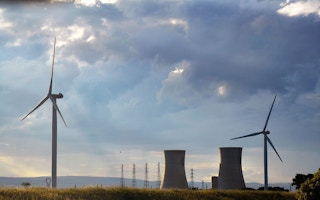At the 2015 United Nations Climate Change Conference in Paris, world leaders at last seemed to recognise the reality of climate change. But the response they are pursuing is fundamentally flawed, given its dependence on “renewable energy sources”—such as solar, hydro, and wind power, as well as biofuels—that actually damage nature. Ironically, the world’s best bet to achieve the Paris agreement’s goals is to rely on an energy source that is often demonised: nuclear power.
Water, wind, and solar power cannot reliably provide energy on the scale required for a modern economy. One kilogram (2.2 pounds) of water behind a dam that is 100 meters (328 feet) high can provide just 1/3,600 kilowatt hours of energy. One kilogram of coal, by contrast, provides about 7 kWh of energy—20,000 times more.
A hydroelectric scheme would thus have to be enormous to generate the same amount of energy as a coal-fired equivalent, implying high environmental and human costs.
To build the largest existing hydroelectric project—the Three Gorges reservoir on the Yangtze River, which stretches for 600 kilometers (373 miles)—1.3 million people were relocated, as 13 cities, 140 towns, and 1,350 villages were inundated.
Wind has a similar energy density. Even with their large and noisy turbines, offshore wind farms produce, at their peak, as little as nine megawatts per square kilometer. To match a one-gigawatt coal-fired plant requires several hundred turbines. The same goes for solar farms: to be competitive, they must be huge, covering vast areas of hillside and meadow.
Yet, even if these massive and environmentally damaging structures were installed, they would be unable to produce enough energy reliably. Articles touting the peak power generation of wind and solar often fail to mention that, for periods that sometimes last many days, they offer little to none. If excess energy could be stored efficiently, the lean periods might be covered; but improvements in battery technology are limited by the laws of chemistry.
“
The world must move beyond radiation phobia and accept more relaxed, evidence-based nuclear regulations.
A recent claim that renewable sources alone could supply all of the United States’ electricity needs has been discredited. To avoid blackouts, fully reliable back-up energy sources must be built and kept on stand-by at a cost attributable to the fluctuating renewables.
Some argue that the answer is biofuels such as ethanol and biodiesel, which benefit from subsidies in some places. But, among renewable-energy options, biofuels have the greatest environmental impact of all, because they require large areas of agricultural land and forest, yet fail to retain the carbon dioxide that nature captures so effectively.
Nuclear energy is the one carbon-free energy source without these environmental downsides. In fact, nuclear fuel has 100,000 times the energy density of coal, so that a one-gigawatt nuclear plant would require only 15 hectares of land. Smaller modular plants could blend unobtrusively into the landscape.
Moreover, nuclear ores are widespread geographically, and the fuel is easily transported and stockpiled. And a nuclear plant—which can operate for 60 years—is more resilient to extreme weather than wind or solar plants.
Despite these advantages, countries around the world are refusing to invest in new nuclear plants and are even shutting down those that already exist. The reason lies in a lack of understanding of how we are exposed to radiation from nuclear processes—an integral part of nature—every day.
For three billion years, life has evolved not to be adversely affected by natural radiation from rocks and space. A century ago, Marie Curie received two Nobel Prizes for explaining the physics and chemistry of nuclear physics and radiation, before pioneering the use of high doses of radiation for cancer treatment.
Yet, while virtually everyone has a relative or friend who has benefited from radiotherapy, public attitudes toward nuclear energy and radiation never recovered from the shock of the nuclear bombs dropped on Hiroshima and Nagasaki in 1945. But the long-term effects of the radiation released by those bombs have been greatly exaggerated.
True, up to 200,000 people may have died in the bombings and their immediate aftermath, but that was mainly from the blast and resulting firestorm. Few died of cancer. Indeed, the medical records of survivors indicate an extra 550-850 cancer deaths over 50 years.
It did not help that, during the Cold War, politicians and media exploited fear of radiation. Draconian safety regulations were enacted in the 1950s, not because evidence demanded it, but to appease an anxious public whose concerns were exacerbated by the nuclear-arms race between the US and the Soviet Union.
In 1986, the nuclear accident at Chernobyl seemed to confirm these fears, though the radiation death toll of that event was just 43. Likewise, although no one died from radiation released by the 2011 accident at Japan’s Fukushima Daiichi plant, that episode was widely regarded as proof that countries should abandon nuclear power.
The negative impact of Fukushima—including 1,600 deaths and severe economic and environmental damage—were the result of inept regulation and evacuation procedures. And what caused the accident in the first place was geology, not the pursuit of nuclear power.
The world must move beyond radiation phobia and accept more relaxed, evidence-based nuclear regulations. (It is compliance with excessive regulations that makes nuclear power apparently expensive.) What is required, above all, is the political will to challenge the status quo, in the name of smart and forward-thinking policy choices, and better education of the public (beginning with schoolchildren and higher investment in education).
Nuclear power may not be popular today, but it should be tomorrow. It is the best choice for our collective future. We should embrace it.
Wade Allison is Emeritus Professor of Physics and Fellow of Keble College at the University of Oxford and the author, most recently, of Nuclear is for Life: A Cultural Revolution. He is also Honorary Secretary of SONE (Supporters of Nuclear Energy).
Copyright: Project Syndicate, 2018. www.project-syndicate.org









